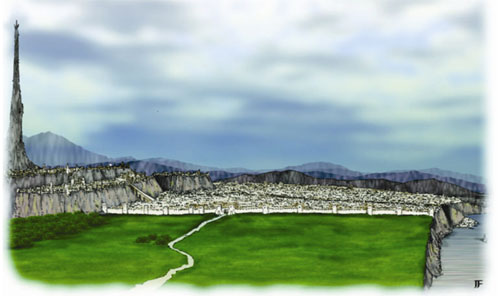IN THE SHADOW OF THE SPIRE
Today I’m posting the first entry in the campaign journal for Ptolus: In the Shadow of the Spire. It takes the form of the background for a character named Agnarr (created by David Blackmer).
The common view of character creation is often that of a solo affair: The player creates their character and then brings it to the game. But I’ve always viewed the creation of a player character as a collaborative process.
STEP 0: THE CAMPAIGN CONCEPT
Before any character is created there’s the campaign concept. This can be roughly broken down as the answer to three questions: Who are the characters? What do they do? Where do they do it?
One of the traditional advantages D&D has enjoyed over many other roleplaying games is that it comes with a flexible but clear-cut concept: 99 out of 100 D&D campaigns are about a group of adventurers exploring dungeons and slaying dragons in a Tolkienesque fantasy setting. If someone says, “Hey, you want to play D&D?” You’ve already got a pretty good idea what that campaign is going to look like.
On the other hand, if someone says, “Hey, you want to play Heavy Gear?” The only question that answers is, “Where do they do it?” (The planet Terra Nova in the seventh millennium.) It leaves completely unanswered the questions of who the characters are and what they do: They could be members of a Saragossan terrorist cell; they could be soldiers in a military strike team; they could be mercenaries in the Badlands; they could be arena gladiators; and so forth.
And, of course, if someone says, “Hey, do you want to play GURPS?” They haven’t told you anything about the campaign concept. You could be playing anything from anthropomorphic cavemen to transhuman cyber hackers.
The creation of a campaign concept can, in itself, be a collaborative process. The question, “What do you guys want to play next?” is basically the most simplistic form of that. But in addition to answering the three basic questions (Who? What? Where?), the GM can also create a discussion about specific themes and even events that the players would like to explore.
Even with D&D, it’s still a good idea to communicate a more specific campaign concept. There is a difference, for example, between the characters who will be effective in urban, rural, and subterranean environments. (And, of course, even larger differences are also possible.) You shouldn’t bring a knife to a gunfight, and your players will have more fun if they don’t bring a woodland druid loaded up with Knowledge (nature) and Survival skills to an all-urban campaign with nary a tree in sight.
In the case of In the Shadow of the Spire, the central structure of the campaign is based around a major mystery. That mystery is literally launched in the very first moment of the campaign, and I didn’t want to spoil that initial moment of surprise. This made it difficult to discuss the deeper campaign concept with the players, but I was still able to tell them the big picture:
The entire campaign will take place within the city of Ptolus — a major city-state that serves as Arathia’s only port on the Southern Sea. It’s a cosmopolitan city. There are elven enclaves from the Teeth of Light; a large dwarven population descended from the refugees of the Kingdoms of the East; a rare population of centaurs; and even that strange and enigmatic litorians. In recent years, vast subterranean complexes, laden with treasure, have been discovered beneath the streets of the city. A gold rush of sorts has erupted around the exploration and looting of these complexes.

From a more abstract point of view: In the Shadow of the Spire will be a combination of urban adventures and dungeoneering. There will be a good mix of standard dungeon-crawling, diplomatic intrigue, and complex investigation.
Now, with this campaign concept in hand, it’s time to start working on the actual characters.











